碳纤维增强复合材料
碳纤维增强材料
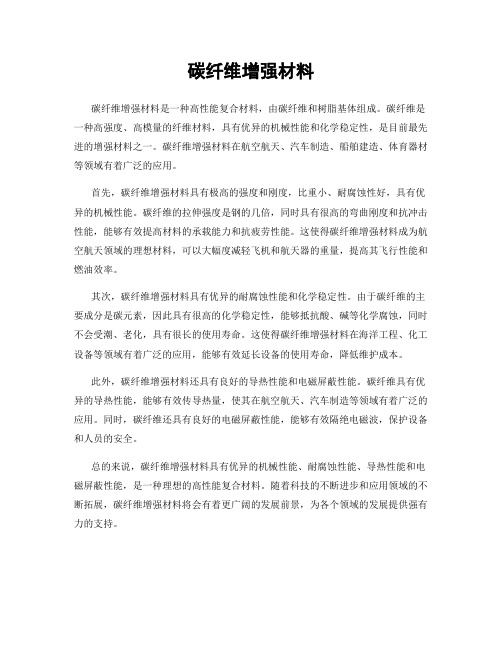
碳纤维增强材料
碳纤维增强材料是一种高性能复合材料,由碳纤维和树脂基体组成。
碳纤维是一种高强度、高模量的纤维材料,具有优异的机械性能和化学稳定性,是目前最先进的增强材料之一。
碳纤维增强材料在航空航天、汽车制造、船舶建造、体育器材等领域有着广泛的应用。
首先,碳纤维增强材料具有极高的强度和刚度,比重小、耐腐蚀性好,具有优异的机械性能。
碳纤维的拉伸强度是钢的几倍,同时具有很高的弯曲刚度和抗冲击性能,能够有效提高材料的承载能力和抗疲劳性能。
这使得碳纤维增强材料成为航空航天领域的理想材料,可以大幅度减轻飞机和航天器的重量,提高其飞行性能和燃油效率。
其次,碳纤维增强材料具有优异的耐腐蚀性能和化学稳定性。
由于碳纤维的主要成分是碳元素,因此具有很高的化学稳定性,能够抵抗酸、碱等化学腐蚀,同时不会受潮、老化,具有很长的使用寿命。
这使得碳纤维增强材料在海洋工程、化工设备等领域有着广泛的应用,能够有效延长设备的使用寿命,降低维护成本。
此外,碳纤维增强材料还具有良好的导热性能和电磁屏蔽性能。
碳纤维具有优异的导热性能,能够有效传导热量,使其在航空航天、汽车制造等领域有着广泛的应用。
同时,碳纤维还具有良好的电磁屏蔽性能,能够有效隔绝电磁波,保护设备和人员的安全。
总的来说,碳纤维增强材料具有优异的机械性能、耐腐蚀性能、导热性能和电磁屏蔽性能,是一种理想的高性能复合材料。
随着科技的不断进步和应用领域的不断拓展,碳纤维增强材料将会有着更广阔的发展前景,为各个领域的发展提供强有力的支持。
碳纤维复合材料的成型工艺

碳纤维复合材料的成型工艺一、碳纤维复合材料概述碳纤维复合材料是一种由碳纤维增强体和树脂基体组成的新型高性能材料。
它以其轻质、高强度、高刚度、耐疲劳、耐腐蚀等优异性能,在航空航天、汽车制造、体育器材、建筑结构等领域得到了广泛的应用。
本文将探讨碳纤维复合材料的成型工艺,分析其重要性、挑战以及实现途径。
1.1 碳纤维复合材料的特点碳纤维复合材料的特点主要包括以下几个方面:- 轻质高强:碳纤维具有很高的比强度和比模量,使得复合材料在保持轻质的同时,具有很高的承载能力。
- 高刚度:碳纤维复合材料的刚度远高于传统材料,可以提供更好的结构稳定性。
- 耐疲劳:碳纤维复合材料具有优异的耐疲劳性能,适用于承受反复循环载荷的应用。
- 耐腐蚀:碳纤维复合材料对多种腐蚀性介质具有很好的抵抗力,适用于恶劣环境。
1.2 碳纤维复合材料的应用领域碳纤维复合材料的应用领域非常广泛,包括但不限于以下几个方面:- 航空航天:用于飞机结构、发动机部件等,以减轻重量、提高性能。
- 汽车制造:用于车身、底盘等部件,以提高燃油效率和车辆性能。
- 体育器材:用于自行车、网球拍、高尔夫球杆等,以提供更好的运动性能。
- 建筑结构:用于桥梁、高层建筑等,以提高结构的承载能力和耐久性。
二、碳纤维复合材料的成型工艺碳纤维复合材料的成型工艺是实现其优异性能的关键环节。
不同的成型工艺会影响材料的性能和应用范围。
2.1 预浸料成型工艺预浸料成型工艺是一种常用的碳纤维复合材料成型方法。
该工艺首先将碳纤维与树脂基体预先混合,形成预浸料,然后在模具上铺设预浸料,通过热压或真空袋压等方法固化成型。
预浸料成型工艺具有成型效率高、产品质量好等优点。
2.2 树脂传递模塑成型工艺树脂传递模塑(RTM)成型工艺是一种先进的复合材料成型技术。
该工艺通过将树脂注入闭合模具中,使树脂在模具内流动并浸润碳纤维,最终固化成型。
RTM工艺可以实现复杂形状的制品成型,且具有较低的生产成本。
碳纤维增强复合材料
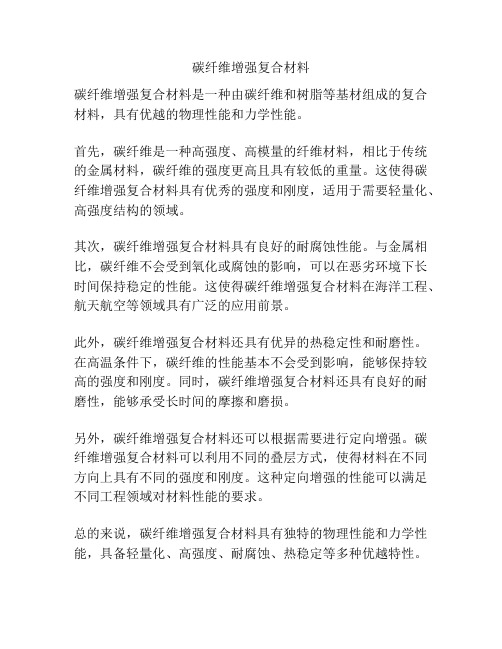
碳纤维增强复合材料
碳纤维增强复合材料是一种由碳纤维和树脂等基材组成的复合材料,具有优越的物理性能和力学性能。
首先,碳纤维是一种高强度、高模量的纤维材料,相比于传统的金属材料,碳纤维的强度更高且具有较低的重量。
这使得碳纤维增强复合材料具有优秀的强度和刚度,适用于需要轻量化、高强度结构的领域。
其次,碳纤维增强复合材料具有良好的耐腐蚀性能。
与金属相比,碳纤维不会受到氧化或腐蚀的影响,可以在恶劣环境下长时间保持稳定的性能。
这使得碳纤维增强复合材料在海洋工程、航天航空等领域具有广泛的应用前景。
此外,碳纤维增强复合材料还具有优异的热稳定性和耐磨性。
在高温条件下,碳纤维的性能基本不会受到影响,能够保持较高的强度和刚度。
同时,碳纤维增强复合材料还具有良好的耐磨性,能够承受长时间的摩擦和磨损。
另外,碳纤维增强复合材料还可以根据需要进行定向增强。
碳纤维增强复合材料可以利用不同的叠层方式,使得材料在不同方向上具有不同的强度和刚度。
这种定向增强的性能可以满足不同工程领域对材料性能的要求。
总的来说,碳纤维增强复合材料具有独特的物理性能和力学性能,具备轻量化、高强度、耐腐蚀、热稳定等多种优越特性。
随着科技的不断发展和应用领域的扩大,碳纤维增强复合材料必将在各个领域发挥更广泛的作用。
碳纤维增强碳化硅复合材料 制备原理

碳纤维增强碳化硅复合材料制备原理今天来聊聊碳纤维增强碳化硅复合材料制备原理的那些事儿。
你看啊,我们生活中经常能看到钢筋混凝土结构的建筑。
混凝土就好比是碳化硅,它本身有一定的强度,但是比较脆。
而钢筋呢,就像是碳纤维,韧性比较好。
当把钢筋加到混凝土里,就组成了一种很厉害的建筑材料,能够承受更大的压力和拉力。
碳纤维增强碳化硅复合材料也是一样的道理。
说到这,你可能会问,那具体是怎么把碳纤维加到碳化硅里的呢?这就要说到制备的原理了。
首先呢,有一个重要的方法叫化学气相渗透(CVI)。
我一开始接触这个的时候也很困惑,这名字听起来就很专业、很复杂。
我就把它想象成蒸馒头的过程,馒头是在蒸汽的包围下逐渐成型的。
在化学气相渗透中呢,碳化硅是以气相的形式存在的,就像馒头周围的蒸汽一样,然后这些气相的碳化硅分子一点点地渗透到碳纤维的结构里,就像蒸汽渗透到馒头的面粉结构里一样,最后冷却凝固,就得到了碳纤维增强碳化硅复合材料。
还有一种方法叫先驱体浸渍裂解法(PIP)。
我学习这个的时候觉得这像是给香肠灌肉的过程。
把碳纤维当作是香肠的肠衣,先驱体就像是要灌进去的肉糜。
先把先驱体浸渍到碳纤维里,然后通过加热让先驱体裂解转化成碳化硅,就像肉糜在加工后变成香肠内部的肉质一样。
这种碳纤维增强碳化硅复合材料有很大的实用价值。
比如说在航空航天领域,飞机发动机在高速运转的时候面临着高温、高速气流、巨大压力等极端条件。
这个复合材料就像我们上面说的钢筋混凝土一样,既有碳化硅耐高温的特性,又有碳纤维的韧性,能够很好地承受这些极端条件,让发动机运行得更稳定,还能减轻重量提高燃油效率呢。
不过呢,这种制备也有注意事项。
它对原料的纯度要求比较高,如果原料中有杂质,就像我们蒸馒头时面粉里夹杂着沙子,那就会使做出来的复合材料性能大打折扣。
老实说,虽然我研究了一些制备原理,但这领域还有很多未知的地方呢。
比如怎么进一步优化制备工艺,降低成本。
这就给我们留下了很多思考的空间,也希望大家能一起来讨论呀。
碳纤维增强铝基复合材料

应用领域
航空航天
用于制造飞机和航天器 的结构件,以减轻重量
并提高结构强度。
汽车工业
用于制造汽车车身、底 盘和零部件,提高汽车
性能和燃油经济性。
体育器材
用于制造轻量化、高强 度的运动器材,如自行 车架、高尔夫球杆等。
电子产品
用于制造轻薄、强度高 的电子设备外壳和内部
支撑结构。
碳纤维增强铝基复合
02
汽车工业领域
节能减排需求
降低生产成本
随着环保意识的提高,汽车工业领域对节 能减排的需求日益迫切,碳纤维增强铝基 复合材料具有轻量化和节能的特点。
通过采用碳纤维增强铝基复合材料, 可以简化生产流程,降低生产成本。
提高车辆性能
采用碳纤维增强铝基复合材料可以提 升汽车的结构性能和舒适性,提高车 辆的操控性和安全性。
良好的耐腐蚀性
碳纤维增强铝基复合材料具有良好的耐腐蚀性,能够抵抗大气、水和酸的侵蚀。 由于铝基体本身具有一定的耐腐蚀性,加上碳纤维对铝基体的保护作用,该材料 的耐腐蚀性能得到进一步提高。
在腐蚀环境下,碳纤维增强铝基复合材料的表面形成一层致密的氧化膜,能够有 效阻止腐蚀介质侵入材料内部。此外,该材料还具有较强的抗疲劳性能和抗应力 腐蚀能力,能够长期保持性能稳定。
在浸渗过程中,铝液会与碳纤 维发生反应,形成碳纤维增强 铝基复合材料。
该方法适用于制备大型和复杂 的构件,但需要严格控制浸渗 温度和时间。
喷射沉积法
将铝液和碳纤维通过高速喷射的方式同时喷入到沉积室内,在沉积室内形成复合材 料。
喷射沉积法可以制备出具有优良性能的碳纤维增强铝基复合材料,且生产效率高。
THANKS.
的要求。
其他领域
建筑领域
碳纤维增强复合材料概述doc

碳纤维增强复合材料概述doc碳纤维增强复合材料由碳纤维和树脂基体构成,是一种具有高强度、低密度、高刚度和耐腐蚀性能的先进材料。
它的独特性能使其在航空航天、汽车、体育器材等领域得到广泛应用。
本文将对碳纤维增强复合材料的制备方法、性能特点及应用领域进行概述。
碳纤维增强复合材料的制备方法有两种主要的工艺路线,分别是预浸法(或称预浸料法)和干法。
在预浸法中,碳纤维将预先浸渍于树脂基体中,然后通过热固化或光固化过程,使其形成固态复合材料。
而在干法制备中,碳纤维和树脂基体分别以纤维片和树脂薄膜的形式制备,并通过层叠和热压等工艺将其结合在一起。
碳纤维增强复合材料具有许多出色的性能特点,其中最显著的就是其很高的强度和刚度。
与传统的金属材料相比,碳纤维复合材料的强度和刚度可以提高数倍甚至数十倍。
此外,碳纤维的密度非常低,使得复合材料具有较轻的重量。
这种轻量化的特性使得碳纤维复合材料成为飞机、汽车等领域的理想选择,能够降低能源消耗和减少环境污染。
另外,碳纤维增强复合材料还具有较高的耐腐蚀性能。
碳纤维本身具有优异的抗腐蚀能力,而且复合材料的树脂基体能够有效隔离外界湿气和化学物质的侵蚀,从而提高材料的耐腐蚀性。
这使得碳纤维复合材料在海洋、化工等腐蚀性环境下具有广阔的应用前景。
碳纤维增强复合材料的应用领域广泛。
在航空航天领域,碳纤维复合材料被广泛应用于飞机机身、翼梁、尾翼等部件中,以降低重量和提高强度,同时提高燃料效率和航程。
在汽车领域,碳纤维复合材料可以用于车身、底盘等部件的制造,以提高车辆的性能和安全性。
此外,碳纤维复合材料还被用于制作体育器材、建筑材料等。
总之,碳纤维增强复合材料是一种具有优异性能的先进材料,其高强度、低密度、高刚度和耐腐蚀性能使其在各个领域具有广泛应用前景。
随着科技的不断进步,碳纤维增强复合材料将会在更多的领域发挥重要作用,推动现代工业的发展和进步。
碳纤维增强复合材料
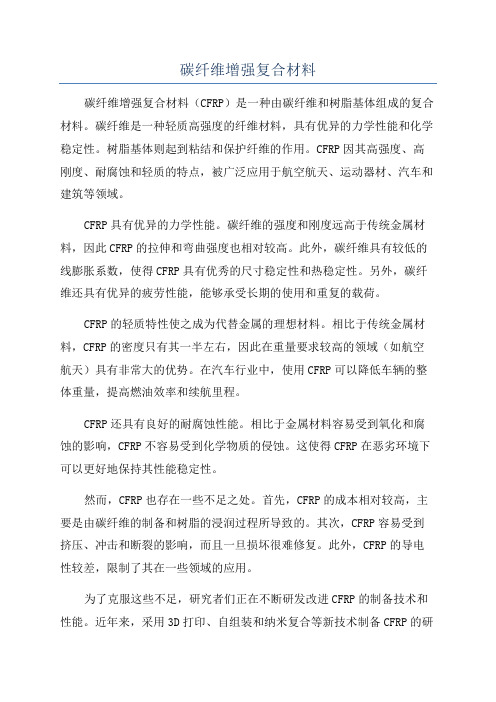
碳纤维增强复合材料碳纤维增强复合材料(CFRP)是一种由碳纤维和树脂基体组成的复合材料。
碳纤维是一种轻质高强度的纤维材料,具有优异的力学性能和化学稳定性。
树脂基体则起到粘结和保护纤维的作用。
CFRP因其高强度、高刚度、耐腐蚀和轻质的特点,被广泛应用于航空航天、运动器材、汽车和建筑等领域。
CFRP具有优异的力学性能。
碳纤维的强度和刚度远高于传统金属材料,因此CFRP的拉伸和弯曲强度也相对较高。
此外,碳纤维具有较低的线膨胀系数,使得CFRP具有优秀的尺寸稳定性和热稳定性。
另外,碳纤维还具有优异的疲劳性能,能够承受长期的使用和重复的载荷。
CFRP的轻质特性使之成为代替金属的理想材料。
相比于传统金属材料,CFRP的密度只有其一半左右,因此在重量要求较高的领域(如航空航天)具有非常大的优势。
在汽车行业中,使用CFRP可以降低车辆的整体重量,提高燃油效率和续航里程。
CFRP还具有良好的耐腐蚀性能。
相比于金属材料容易受到氧化和腐蚀的影响,CFRP不容易受到化学物质的侵蚀。
这使得CFRP在恶劣环境下可以更好地保持其性能稳定性。
然而,CFRP也存在一些不足之处。
首先,CFRP的成本相对较高,主要是由碳纤维的制备和树脂的浸润过程所导致的。
其次,CFRP容易受到挤压、冲击和断裂的影响,而且一旦损坏很难修复。
此外,CFRP的导电性较差,限制了其在一些领域的应用。
为了克服这些不足,研究者们正在不断研发改进CFRP的制备技术和性能。
近年来,采用3D打印、自组装和纳米复合等新技术制备CFRP的研究逐渐增多。
这些方法可以有效地降低CFRP的成本,提高其性能。
此外,通过在复合材料中引入导电纳米材料,可以使CFRP具有良好的导电性能,从而扩展其应用范围。
综上所述,碳纤维增强复合材料是一种具有高强度、高刚度、轻质和耐腐蚀性能的材料。
尽管CFRP存在一些不足,但随着技术的不断进步,相信CFRP在未来将有更广泛的应用前景。
碳纤维增强复合材料的力学性能和设计
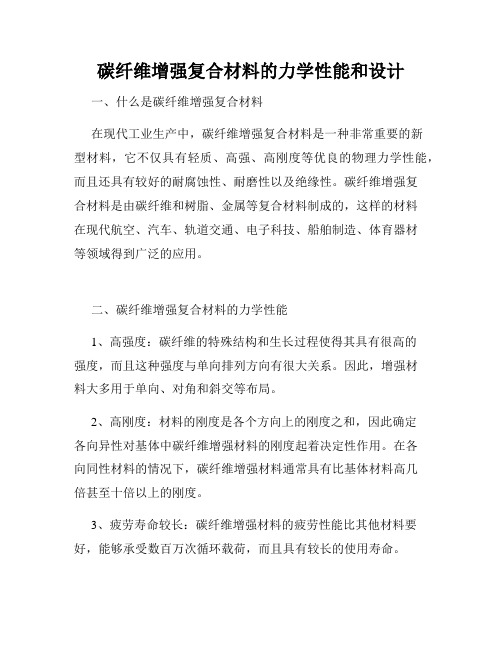
碳纤维增强复合材料的力学性能和设计一、什么是碳纤维增强复合材料在现代工业生产中,碳纤维增强复合材料是一种非常重要的新型材料,它不仅具有轻质、高强、高刚度等优良的物理力学性能,而且还具有较好的耐腐蚀性、耐磨性以及绝缘性。
碳纤维增强复合材料是由碳纤维和树脂、金属等复合材料制成的,这样的材料在现代航空、汽车、轨道交通、电子科技、船舶制造、体育器材等领域得到广泛的应用。
二、碳纤维增强复合材料的力学性能1、高强度:碳纤维的特殊结构和生长过程使得其具有很高的强度,而且这种强度与单向排列方向有很大关系。
因此,增强材料大多用于单向、对角和斜交等布局。
2、高刚度:材料的刚度是各个方向上的刚度之和,因此确定各向异性对基体中碳纤维增强材料的刚度起着决定性作用。
在各向同性材料的情况下,碳纤维增强材料通常具有比基体材料高几倍甚至十倍以上的刚度。
3、疲劳寿命较长:碳纤维增强材料的疲劳性能比其他材料要好,能够承受数百万次循环载荷,而且具有较长的使用寿命。
4、耐磨性强:碳纤维增强材料具有较高的物理力学性能,因此具有很强的耐磨性,特别适合用于制造高速运动的器械。
三、碳纤维增强复合材料的设计1、确定应用载荷:设计时必须要先明确碳纤维增强复合材料所要承受的载荷种类,包括静载和动载。
2、确定应变水平:应变水平是材料破坏的重要参数之一,针对不同应变水平设计不同的材料也是十分必要的。
合适的应变水平设计可以确保材料在特定要求下具有最佳性能。
3、确定强度参数:材料的强度是指承受载荷时材料破坏的极限值。
因此,通过实验和仿真计算来得到材料的破坏极限值,再以此为依据来确定设计强度决策。
4、考虑制造成本:设计材料必须要考虑到成本因素,包括制造、运输、安装等费用。
因此,在涉及到大批量生产时,提前考虑到成本问题十分重要,可以有效降低生产成本。
四、结论碳纤维增强复合材料在现代工业生产中具有十分广泛的应用,由于其具有很高的物理力学性能,设计时需要考虑的因素也比较多。
碳纤维增强复合材料

碳纤维增强复合材料
首先,碳纤维增强复合材料由碳纤维和树脂基体组成。
碳纤维
是一种高强度、高模量的纤维材料,具有优异的力学性能。
而树脂
基体则起到了粘合和保护碳纤维的作用。
常见的树脂基体包括环氧
树脂、酚醛树脂、聚酰亚胺树脂等。
碳纤维和树脂基体经过复合工艺,可以形成具有优异性能的碳纤维增强复合材料。
其次,制备碳纤维增强复合材料的工艺包括预浸料成型、手工
层叠成型和自动化成型等。
其中,预浸料成型是一种常用的工艺方法,其过程是将碳纤维与树脂预浸料预先混合,然后通过模具成型、固化等工艺步骤,最终得到碳纤维增强复合材料制品。
另外,自动
化成型技术的发展也为碳纤维增强复合材料的大规模生产提供了可能。
碳纤维增强复合材料具有高强度、高刚度和低密度等优异性能。
其拉伸强度和弹性模量分别是钢的2-5倍和5-10倍,而密度却只有
钢的1/4。
因此,碳纤维增强复合材料在航空航天、汽车、船舶等
领域得到了广泛的应用。
在航空航天领域,碳纤维增强复合材料被
用于制造飞机机身、机翼、尾翼等部件,可以减轻飞机重量,提高
燃油效率。
在汽车领域,碳纤维增强复合材料被用于制造车身、底
盘等部件,可以提高汽车的安全性能和燃油经济性。
在船舶领域,碳纤维增强复合材料被用于制造船体、桅杆等部件,可以提高船舶的航行速度和耐久性。
综上所述,碳纤维增强复合材料具有优异的性能和广泛的应用前景。
随着材料科学技术的不断发展,碳纤维增强复合材料将在更多领域得到应用,并为人类社会的发展做出更大的贡献。
碳纤维增强复合材料在航空航天领域的应用
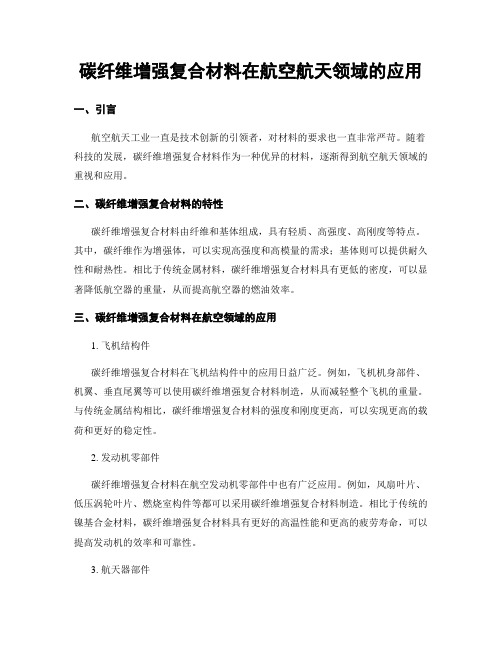
碳纤维增强复合材料在航空航天领域的应用一、引言航空航天工业一直是技术创新的引领者,对材料的要求也一直非常严苛。
随着科技的发展,碳纤维增强复合材料作为一种优异的材料,逐渐得到航空航天领域的重视和应用。
二、碳纤维增强复合材料的特性碳纤维增强复合材料由纤维和基体组成,具有轻质、高强度、高刚度等特点。
其中,碳纤维作为增强体,可以实现高强度和高模量的需求;基体则可以提供耐久性和耐热性。
相比于传统金属材料,碳纤维增强复合材料具有更低的密度,可以显著降低航空器的重量,从而提高航空器的燃油效率。
三、碳纤维增强复合材料在航空领域的应用1. 飞机结构件碳纤维增强复合材料在飞机结构件中的应用日益广泛。
例如,飞机机身部件、机翼、垂直尾翼等可以使用碳纤维增强复合材料制造,从而减轻整个飞机的重量。
与传统金属结构相比,碳纤维增强复合材料的强度和刚度更高,可以实现更高的载荷和更好的稳定性。
2. 发动机零部件碳纤维增强复合材料在航空发动机零部件中也有广泛应用。
例如,风扇叶片、低压涡轮叶片、燃烧室构件等都可以采用碳纤维增强复合材料制造。
相比于传统的镍基合金材料,碳纤维增强复合材料具有更好的高温性能和更高的疲劳寿命,可以提高发动机的效率和可靠性。
3. 航天器部件在航天器部件中,碳纤维增强复合材料也发挥着重要作用。
例如,航天器的外部保护罩、热控制结构等部件可以采用碳纤维增强复合材料制造,以提高航天器的耐热性和抗高温气流的能力。
此外,碳纤维增强复合材料还可以应用于航天器的结构框架和传感器支撑结构等领域。
四、碳纤维增强复合材料的挑战与前景尽管碳纤维增强复合材料在航空航天领域取得了显著的应用成果,但仍面临一些挑战。
首先,其生产成本较高,限制了大规模应用。
其次,碳纤维增强复合材料的损伤检测和维修也相对困难。
此外,随着航空器规模的不断扩大,对碳纤维增强复合材料的性能要求也不断提高,需要更高强度、更高刚度和更好的耐久性。
然而,碳纤维增强复合材料仍然具有广阔的前景。
碳纤维增强复合材料加工及其性能调控

碳纤维增强复合材料加工及其性能调控碳纤维增强复合材料(CFRP)是一种由高强度碳纤维织物和聚合物基质材料组成的材料,具有低密度、高强度、高刚度、抗疲劳性能好等优点,广泛应用于航空、汽车、船舶等领域。
CFRP的制备主要包括纺织成型工艺、注塑成型工艺和高温热固工艺等。
其中,纺织成型工艺是常用的一种方法,它包括纺织预型加工、树脂浸渍和热固化工艺三个步骤。
在纺织预型加工阶段,将碳纤维织物按照设计要求剪裁成一定形状的预型,并在预型中设计和布置一定的加强件和增强筋。
在树脂浸渍阶段,将预先浸渍树脂的碳纤维织物与模具组合,使用真空泵进行真空吸附,达到使树脂浸润纤维并去除空气的目的。
在热固化阶段,通过特定温度下的加热、固化使树脂基质固化使得织物形成固体。
复合材料的性能调控是制备过程中的关键问题之一,其性能受到多种因素的影响,包括树脂种类、纤维种类、纤维取向、表面形貌、制备工艺等。
通过优化这些因素可以调控复合材料的力学性能、物理性能和化学性能等方面。
一般来说,CFRP的机械性能主要是由纤维强度和纤维取向两个因素决定的。
纤维强度是纤维本身固有的性能,通常由纤维的细节、结晶度、纤维的长度和直径等决定。
纤维取向则是指在纺织成型工艺中制备的多层复合材料中纤维的摆放方向。
优化纤维取向可以较大程度地提高复合材料的性能,目前研究表明,当纤维角度为±45°时,复合材料拉伸强度最高,而当纤维平行于载荷方向时,复合材料的弯曲刚度最大。
除了纤维强度和纤维取向之外,树脂基质的性能也对复合材料的性能有着重要的影响。
树脂基质通常由环氧树脂、丙烯腈-丁二烯共聚物、聚酰亚胺等材料组成,其性能直接决定着复合材料的耐热性、抗溶解性、抗湿热性等方面的表现。
在表面形貌方面,如果复合材料的表面粗糙度过大,会导致其疲劳寿命大幅度降低。
而表面处理,如化学蚀刻、微观结构表面调控,可以显著地改善复合材料的表面性质。
总之,CFRP的性能调控是制备过程和应用中的关键问题,对其制备和应用技术的发展都提出了重要的需求。
碳纤维增强复合材料的力学性能

碳纤维增强复合材料的力学性能碳纤维增强复合材料,这名字听起来是不是特别高大上?就好像是从未来穿越过来的神秘材料。
其实啊,在咱们的日常生活和各种工业领域里,它已经悄悄崭露头角啦。
先来说说我对碳纤维增强复合材料的一次特别观察吧。
有一回,我去参观一家汽车制造工厂,在那角落里,我看到了一堆黑漆漆的材料,当时还不知道那就是碳纤维增强复合材料。
只见工人们小心翼翼地摆弄着这些材料,就像对待宝贝似的。
我凑过去仔细一瞧,那材料的表面有着独特的纹理,有点像细细的丝线交织在一起。
那咱们就来好好聊聊它的力学性能。
碳纤维增强复合材料的强度那可真是杠杠的。
打个比方,如果普通材料像是一群小学生拔河,劲儿不大还容易散。
那碳纤维增强复合材料就像是一群大力士在拔河,不仅力气超大,而且还特别团结,不容易被拉开。
它的抗拉强度简直让人惊叹。
想象一下,一根细细的碳纤维增强复合材料线,居然能够承受住好几吨的拉力,就像一个小瘦子有着超级大力气,能轻松举起大卡车一样。
这使得它在航空航天领域大显身手。
飞机的翅膀、火箭的外壳,都能因为它变得更坚固、更轻巧。
碳纤维增强复合材料的抗压能力也不赖。
就好比是一个大力士,不仅能拉得动重物,还能稳稳地扛住重物的压力。
在建筑行业里,用它制造的支撑柱可以承受巨大的建筑重量,而且还不占太多空间。
它的韧性也值得一提。
不像有些材料,稍微一受力就断了,碳纤维增强复合材料就像是一根有弹性的皮筋,能弯曲、能伸展,还不会轻易断掉。
比如说在一些运动器材上,像自行车的车架,用了它之后,既能承受住剧烈的颠簸,又不会变形。
这种材料的耐磨性也很棒。
假如把普通材料比作是容易磨损的鞋底,走几步路就磨破了。
那碳纤维增强复合材料就是那种超级耐磨的鞋底,走了好多好多路,还是完好无损。
在一些机械零件中使用,能够大大延长零件的使用寿命。
碳纤维增强复合材料还有一个厉害的地方,就是它的抗疲劳性能。
就好像一个人可以不停地工作,也不觉得累。
在长期承受反复荷载的情况下,它依然能够保持良好的性能,不会轻易出现疲劳裂纹。
碳纤维增强复合材料的制备及其应用

碳纤维增强复合材料的制备及其应用碳纤维增强复合材料(CFRP)是一种新型材料,具有轻质、高强度、高刚度、耐腐蚀等优点,因此在航空航天、汽车、体育器材等领域有着广泛的应用。
本文将介绍CFRP的制备方法及其应用。
一、CFRP的制备方法1.预制法预制法是指在模具中预先制作出所需的形状和大小的纤维固定体,然后再进行浸渍、热固化等工艺。
这种方法可以使CFRP的成形稳定性和尺寸精度得到保证,适用于大批量生产。
2.自动化纺织法自动化纺织法是用预浸渍的碳纤维进行编织而成的成型方法。
与手工编织相比,自动化纺织法的优点是能够通过程序控制和计算机模拟实现自动化生产,从而提高生产效率和产品的质量稳定性,适用于大面积、复杂形状的CFRP制造。
3.手工层压法手工层压法是将预先预处理的碳纤维布层压在模具中,在配合环氧树脂等树脂粘合剂后进行固化,最后得到所需的形状和尺寸的CFRP。
虽然手工层压法的生产效率较低,但是适用于小批量、复杂形状的CFRP制造。
二、CFRP的应用领域1.航空航天CFRP由于其重量轻、强度高、耐腐蚀等优点,被广泛应用于航天器、卫星、飞机等领域。
例如,美国波音公司的777X飞机翼和垂直尾翼、空客公司的A350XWB机身和机翼、中国自主研发的C919客机等都采用了CFRP。
2.汽车CFRP的轻质、高强度、低密度等优点,使得它成为汽车制造领域的重要材料,例如,特斯拉的Model S和Roadster车型,采用了CFRP车身和底盘,达到了极高的性能和运动感受。
3.体育器材CFRP的高强度、高韧性和轻质,使得它在各种体育器材中得到广泛应用。
例如,高尔夫球杆、网球拍、滑雪板、自行车等都采用了CFRP材料,以提高运动员的表现和运动器材的性能。
三、CFRP的未来发展方向随着科技和工艺的不断进步,CFRP在未来的发展方向将越来越多样化和广泛化。
例如,将CFRP与3D打印技术结合,在器件制造和生产过程中得到量身定制和精细化,从而提高产品质量和生产效率;将CFRP用于建筑领域,打破传统的建筑材料结构,实现更轻薄、更稳定、更耐久的建筑。
碳纤维增强聚合物复合材料
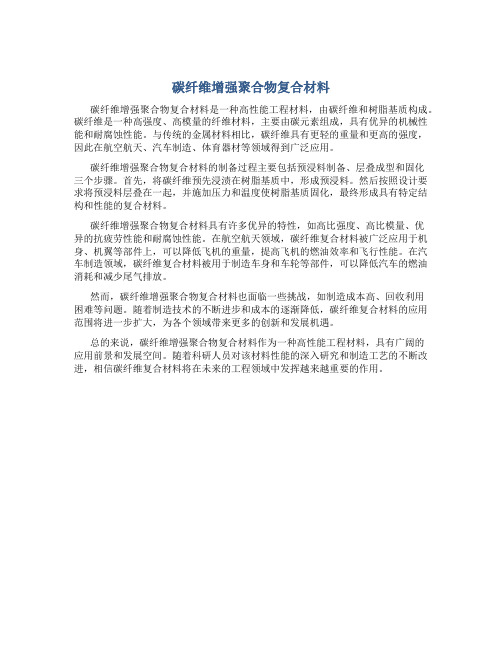
碳纤维增强聚合物复合材料
碳纤维增强聚合物复合材料是一种高性能工程材料,由碳纤维和树脂基质构成。
碳纤维是一种高强度、高模量的纤维材料,主要由碳元素组成,具有优异的机械性能和耐腐蚀性能。
与传统的金属材料相比,碳纤维具有更轻的重量和更高的强度,因此在航空航天、汽车制造、体育器材等领域得到广泛应用。
碳纤维增强聚合物复合材料的制备过程主要包括预浸料制备、层叠成型和固化
三个步骤。
首先,将碳纤维预先浸渍在树脂基质中,形成预浸料。
然后按照设计要求将预浸料层叠在一起,并施加压力和温度使树脂基质固化,最终形成具有特定结构和性能的复合材料。
碳纤维增强聚合物复合材料具有许多优异的特性,如高比强度、高比模量、优
异的抗疲劳性能和耐腐蚀性能。
在航空航天领域,碳纤维复合材料被广泛应用于机身、机翼等部件上,可以降低飞机的重量,提高飞机的燃油效率和飞行性能。
在汽车制造领域,碳纤维复合材料被用于制造车身和车轮等部件,可以降低汽车的燃油消耗和减少尾气排放。
然而,碳纤维增强聚合物复合材料也面临一些挑战,如制造成本高、回收利用
困难等问题。
随着制造技术的不断进步和成本的逐渐降低,碳纤维复合材料的应用范围将进一步扩大,为各个领域带来更多的创新和发展机遇。
总的来说,碳纤维增强聚合物复合材料作为一种高性能工程材料,具有广阔的
应用前景和发展空间。
随着科研人员对该材料性能的深入研究和制造工艺的不断改进,相信碳纤维复合材料将在未来的工程领域中发挥越来越重要的作用。
碳纤维增强材料
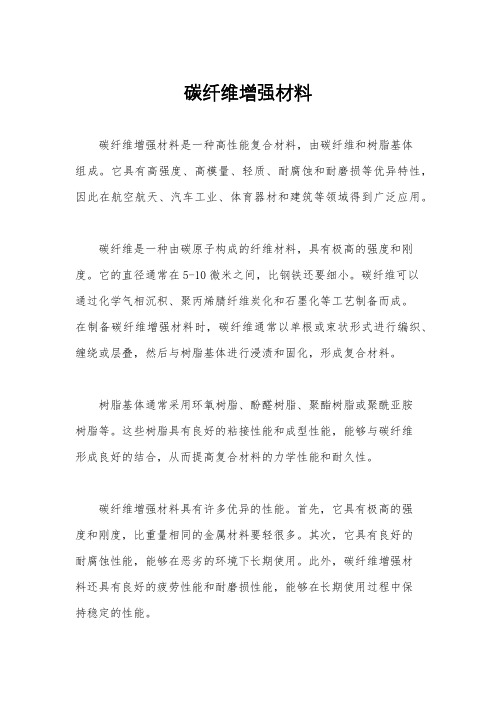
碳纤维增强材料碳纤维增强材料是一种高性能复合材料,由碳纤维和树脂基体组成。
它具有高强度、高模量、轻质、耐腐蚀和耐磨损等优异特性,因此在航空航天、汽车工业、体育器材和建筑等领域得到广泛应用。
碳纤维是一种由碳原子构成的纤维材料,具有极高的强度和刚度。
它的直径通常在5-10微米之间,比钢铁还要细小。
碳纤维可以通过化学气相沉积、聚丙烯腈纤维炭化和石墨化等工艺制备而成。
在制备碳纤维增强材料时,碳纤维通常以单根或束状形式进行编织、缠绕或层叠,然后与树脂基体进行浸渍和固化,形成复合材料。
树脂基体通常采用环氧树脂、酚醛树脂、聚酯树脂或聚酰亚胺树脂等。
这些树脂具有良好的粘接性能和成型性能,能够与碳纤维形成良好的结合,从而提高复合材料的力学性能和耐久性。
碳纤维增强材料具有许多优异的性能。
首先,它具有极高的强度和刚度,比重量相同的金属材料要轻很多。
其次,它具有良好的耐腐蚀性能,能够在恶劣的环境下长期使用。
此外,碳纤维增强材料还具有良好的疲劳性能和耐磨损性能,能够在长期使用过程中保持稳定的性能。
在航空航天领域,碳纤维增强材料被广泛应用于飞机机翼、机身、尾翼和发动机罩等部件,能够显著减轻飞机的重量,提高飞行性能和燃油经济性。
在汽车工业领域,碳纤维增强材料被应用于车身、底盘和发动机部件,能够提高汽车的安全性能和燃油经济性。
在体育器材领域,碳纤维增强材料被应用于高尔夫球杆、网球拍和自行车等器材,能够提高器材的性能和使用寿命。
在建筑领域,碳纤维增强材料被应用于桥梁、楼梯和地板等结构件,能够提高建筑的抗震性能和耐久性。
总之,碳纤维增强材料具有极高的强度、刚度和耐久性,能够在航空航天、汽车工业、体育器材和建筑等领域发挥重要作用。
随着科学技术的不断进步,碳纤维增强材料将会得到更广泛的应用,并为人类社会的发展做出更大的贡献。
碳纤维增强材料

碳纤维增强材料碳纤维增强材料(Carbon Fiber Reinforced Polymer,CFRP)是一种由碳纤维和树脂基体组成的复合材料,具有高强度、高模量、轻质化、耐腐蚀、耐疲劳等优良性能。
由于其独特的性能特点,碳纤维增强材料在航空航天、汽车制造、建筑工程、体育器材等领域得到了广泛的应用。
首先,碳纤维增强材料具有高强度和高模量的特点。
碳纤维本身具有极高的拉伸强度和模量,使得其在复合材料中能够有效地提高材料的整体强度和刚度。
与传统的金属材料相比,碳纤维增强材料具有更高的比强度和比模量,能够在保证结构强度的同时实现轻量化设计,满足现代工程领域对材料强度和重量的双重需求。
其次,碳纤维增强材料具有优良的耐腐蚀性能。
由于碳纤维本身具有化学稳定性,不易受到酸碱腐蚀的影响,因此碳纤维增强材料在恶劣环境下具有较好的耐腐蚀性能,能够有效延长材料的使用寿命,降低维护成本,提高材料的可靠性和稳定性。
此外,碳纤维增强材料还具有良好的疲劳性能。
碳纤维材料具有较高的疲劳强度和疲劳寿命,能够在长期循环加载下保持良好的性能稳定性,因此在航空航天和汽车制造等领域得到了广泛的应用。
碳纤维增强材料还具有优秀的成型性能和设计自由度,能够实现复杂结构的制造和设计,满足不同领域对材料性能和形状的需求。
总的来说,碳纤维增强材料具有高强度、高模量、轻质化、耐腐蚀、耐疲劳等优良性能,是一种理想的结构材料。
随着科学技术的不断发展,碳纤维增强材料在航空航天、汽车制造、建筑工程、体育器材等领域的应用将会越来越广泛,为人类社会的发展和进步带来更多的机遇和挑战。
希望在未来的发展中,碳纤维增强材料能够发挥更大的作用,为人类社会的可持续发展做出更大的贡献。
碳纤维增强复合材料

碳纤维增强复合材料
首先,碳纤维增强复合材料的制备工艺包括预浸料法、手工层叠法、自动纺织
成型法等。
预浸料法是将碳纤维预先浸渍于树脂中,然后再进行成型和固化,这种工艺能够保证复合材料的质量和性能稳定。
手工层叠法是将预浸的碳纤维逐层手工叠放在模具中,然后浸渍树脂并进行固化,这种工艺成本低廉但生产效率低。
自动纺织成型法是利用自动化设备将预浸的碳纤维布料进行成型,然后进行固化,这种工艺能够快速高效地生产复合材料。
其次,碳纤维增强复合材料具有优异的力学性能,其比强度和比模量分别是金
属材料的2-5倍和5-10倍,因此能够在相同强度下减轻结构重量,提高结构的载
荷能力。
同时,碳纤维增强复合材料具有优异的疲劳性能和耐腐蚀性能,在复杂的工程环境中能够保持稳定的性能。
再者,碳纤维增强复合材料在航空航天领域得到广泛应用,例如飞机机身、机翼、舵面等结构件均采用碳纤维增强复合材料,能够显著减轻飞机重量,提高燃油效率,同时具有优异的抗疲劳和耐腐蚀性能,能够提高飞机的使用寿命和安全性。
最后,随着碳纤维增强复合材料制备工艺的不断改进和成本的降低,其在汽车、船舶、体育器材等领域的应用也在不断扩大。
碳纤维增强复合材料能够有效减轻汽车和船舶的重量,提高燃油效率和行驶性能,同时具有优异的外观和表面质量,能够满足高端体育器材对轻量化和高性能的要求。
总之,碳纤维增强复合材料以其优异的性能和广泛的应用前景,成为当今材料
科学领域的研究热点,随着技术的不断进步,相信碳纤维增强复合材料在未来将有更广阔的发展空间。
连续碳纤维增强热塑性复合材料的性能优势及应用举例
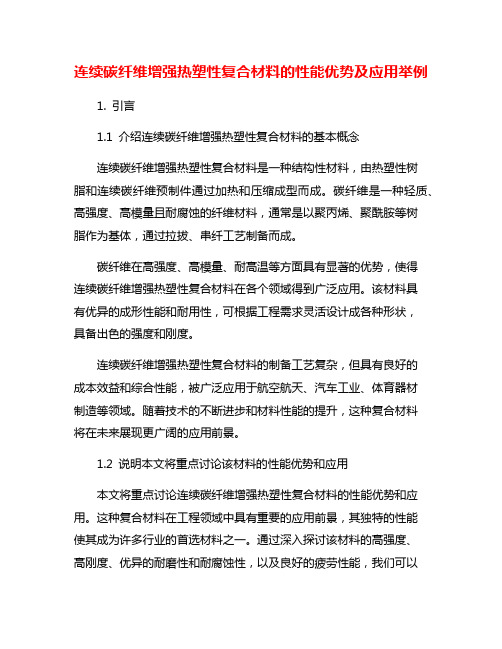
连续碳纤维增强热塑性复合材料的性能优势及应用举例1. 引言1.1 介绍连续碳纤维增强热塑性复合材料的基本概念连续碳纤维增强热塑性复合材料是一种结构性材料,由热塑性树脂和连续碳纤维预制件通过加热和压缩成型而成。
碳纤维是一种轻质、高强度、高模量且耐腐蚀的纤维材料,通常是以聚丙烯、聚酰胺等树脂作为基体,通过拉拔、串纤工艺制备而成。
碳纤维在高强度、高模量、耐高温等方面具有显著的优势,使得连续碳纤维增强热塑性复合材料在各个领域得到广泛应用。
该材料具有优异的成形性能和耐用性,可根据工程需求灵活设计成各种形状,具备出色的强度和刚度。
连续碳纤维增强热塑性复合材料的制备工艺复杂,但具有良好的成本效益和综合性能,被广泛应用于航空航天、汽车工业、体育器材制造等领域。
随着技术的不断进步和材料性能的提升,这种复合材料将在未来展现更广阔的应用前景。
1.2 说明本文将重点讨论该材料的性能优势和应用本文将重点讨论连续碳纤维增强热塑性复合材料的性能优势和应用。
这种复合材料在工程领域中具有重要的应用前景,其独特的性能使其成为许多行业的首选材料之一。
通过深入探讨该材料的高强度、高刚度、优异的耐磨性和耐腐蚀性,以及良好的疲劳性能,我们可以更好地了解其在各个领域中的优势和潜在应用。
在接下来的内容中,我们将详细讨论连续碳纤维增强热塑性复合材料在汽车工业、航空航天领域和体育器材制造中的具体应用例子。
通过这些案例,读者可以更加直观地了解该材料的实际应用场景以及其对这些行业的推动作用。
我们将总结该材料的性能优势和广泛应用,并展望其在未来的发展前景。
【字数:207】2. 正文2.1 连续碳纤维增强热塑性复合材料的性能优势1. 高强度和高刚度:连续碳纤维增强热塑性复合材料具有高强度和高刚度的特点,这是由于碳纤维本身具有优异的机械性能,能够承受较大的拉伸和压缩力。
在复合材料中,碳纤维与热塑性树脂的结合,使其具备更强的强度和刚度,能够承受更大的力和扭矩,适用于要求高强度和高刚度的应用场合。
碳纤维增强基复合材料

碳纤维增强基复合材料碳纤维增强基复合材料是一种由碳纤维和基体材料组成的复合材料,具有轻质、高强度、耐腐蚀等优点,被广泛应用于航空航天、汽车制造、体育器材等领域。
本文将从碳纤维的特性、基体材料的选择、制备工艺和应用领域等方面进行详细介绍。
首先,碳纤维是一种由碳元素构成的纤维材料,具有轻质、高强度、高模量、耐热、耐腐蚀等优异性能。
碳纤维的拉伸强度和模量分别是普通钢的2倍和5倍以上,是玻璃纤维的6倍和2倍以上。
由于碳纤维具有这些优异的性能,因此被广泛应用于制备复合材料中,以提高复合材料的强度和刚度。
其次,选择合适的基体材料对于碳纤维增强基复合材料的性能至关重要。
常用的基体材料包括树脂、金属、陶瓷等。
树脂基复合材料由于其成型工艺简单、成本低廉、成型自由度大等优点,被广泛应用于航空航天、汽车制造等领域。
金属基复合材料具有良好的导热性和导电性,适用于需要导热导电的场合。
陶瓷基复合材料具有优异的耐磨损性和耐高温性能,适用于高温、高速摩擦等场合。
制备工艺是影响碳纤维增强基复合材料性能的重要因素之一。
常见的制备工艺包括手工层叠、自动化层叠、预浸料成型、纺丝成型等。
手工层叠工艺简单易行,适用于小批量生产;自动化层叠工艺适用于大批量生产,提高了生产效率;预浸料成型工艺能够提高复合材料的成型质量和性能;纺丝成型工艺能够制备出连续纤维增强复合材料,提高了复合材料的强度和韧性。
最后,碳纤维增强基复合材料被广泛应用于航空航天、汽车制造、体育器材等领域。
在航空航天领域,碳纤维增强基复合材料被用于制造飞机机身、机翼等部件,以减轻飞机重量,提高燃油效率;在汽车制造领域,碳纤维增强基复合材料被用于制造汽车车身、底盘等部件,提高汽车的安全性和燃油效率;在体育器材领域,碳纤维增强基复合材料被用于制造高尔夫球杆、网球拍等器材,提高器材的性能和使用寿命。
总之,碳纤维增强基复合材料具有轻质、高强度、耐腐蚀等优异性能,被广泛应用于航空航天、汽车制造、体育器材等领域。
- 1、下载文档前请自行甄别文档内容的完整性,平台不提供额外的编辑、内容补充、找答案等附加服务。
- 2、"仅部分预览"的文档,不可在线预览部分如存在完整性等问题,可反馈申请退款(可完整预览的文档不适用该条件!)。
- 3、如文档侵犯您的权益,请联系客服反馈,我们会尽快为您处理(人工客服工作时间:9:00-18:30)。
02 CFRC
The properties of carbon fiber composites are determined by three main components: fiber, matrix and interface layer.
INTERFACR: Interface is an intermediate phase between the reinforcing phase and the matrix phase, which is the bridge between the reinforcing phase and the matrix, as well as the transmitter of stress and other information.
D400,as a traditional cross-linker of epoxy,
contains two active primary amine groups located on secondary carbon atoms at each end of an aliphatic polyether chain . And flexible polyether chain contributes to stress transfer between carbon fiber and epoxy.
02 CFRC
What is Carbon fiber reinforced composites ?
CFRC is a kind of structural material made of carbon fiber with resin, metal or ceramics.
Excellent tensile strength, high stiffness, light weight and great thermal resistance make carbon fiber reinforced composites an ideal structural material.
RESEARCH AND TREATMENT OF THE SURFACE OF CARBON FIBER IN CARBON FIBER REINFORCED COMPOSITES
contents
PART 01 PART 02 PART 03 PART 04
Introduction CF interface
①the impurities attached to the mold release agent; ②the aging of the interface layer formed when the oxide layer,hydrate layer; ③the substrate is not fully infiltrated and bound by the air layer; …….
Electro polymerization
Whisker growth method
Plasma method
03
PART THREE
Article one
01 GRAFTING
Grafting of micro-molecules or polymers onto the carbon fiber surface can yield a controlled, ordered and active structure, which has can be an effective modification method.
ACF/D400 enforced epoxy composites
03 RESULTS AND DISCUSSION
The following depicts the surface morphologies and roughness of the carbon fibers.
03 RESULTS AND DISCUSSION
IFSS was adopted to quantify the interfacial property between carbon fiber and epoxy.
F----maximum load recorded d----carbon fiber diameter l------embedded length
02
PART TWO
CF interface
01 INTERFACE
The property of CF composites mainly depends on the quality of the interface between the matrix and the reinforcement, which determined the way of the loads transfer from the matrix to the carbon fiber. The improvement of the interfacial adhesion strength between the carbon fiber and polymer matrix is a key factor to improve mechanics performance of composite materials.
03 METHODS TO ENHANCE THE ADHESION
Second, the surface morphology is suitable for bonding.
The increase of surface roughness is beneficial to the mechanical fitting of carbon fiber and matrix resin, and to enhance the effect of anchoring.
02 PROCESSES
CF
HNO3(80℃、4h) washed several times, dried under vacuum
重复性
增强因子
ACF
D400(90℃、4h) HATU was used as condensing agent
Washed dried in a vacuum furnace
Third, improve the affinity of resin and reinforcement.
The introduction of polar or reactive functional groups, and the role of the intermediate layer with resin, such as - COOH, - NH2, - OH.
After adsorption of D400, the IFSS of CF/D400 composite increases to 55.8 MPa which is attributed to improvement of surface energy.
D400,which can not only react with the reactive groups on the carbon fiber surface, but also increase resin compatibility and react with the matrix system. D400 molecules have exactly and completely covered the whole surface of carbon fibers at 2 *10-4 mol/L concentration.
03 RESULTS AND DISCUSSION
The following depicts the surface morphology of carbon fibers after debonding from the epoxy matrix Before grafting(Fig a),the debonding between carbon fiber and epoxy is interfacial failure. After adsorbed D400, more epoxy debris adhere on the carbon fiber after debonding , due to the strong covalent bonds formed between amino and carboxyl groups. As D400 concentration goes up, there is more remaining epoxy resin.
03 METHODS TO ENHANCE THE ADHESION
Vapor phase oxidation
oxidation
Liquid phase oxidation
Catalytic oxidation
surface treatment
Non-oxidation
Vapor deposition method
Composite interface phase
03 METHODS TO ENHANCE THE ADHESION
How to increase the adhesion between CF and resin? First, prevent the formation of weak interface layer.
03 RESULTS AND DISCUSSION
The wettability of carbon fiber is investigated using advancing dynamic contact angle test.
After D400 grafting treatment, the contact angles decrease, while the surface energy of carbon fiber increases. The wettability of carbon fiber was increased and the change of the fiber surface free energy confirms the successful deposition of D400 on carbon fiber surface.
